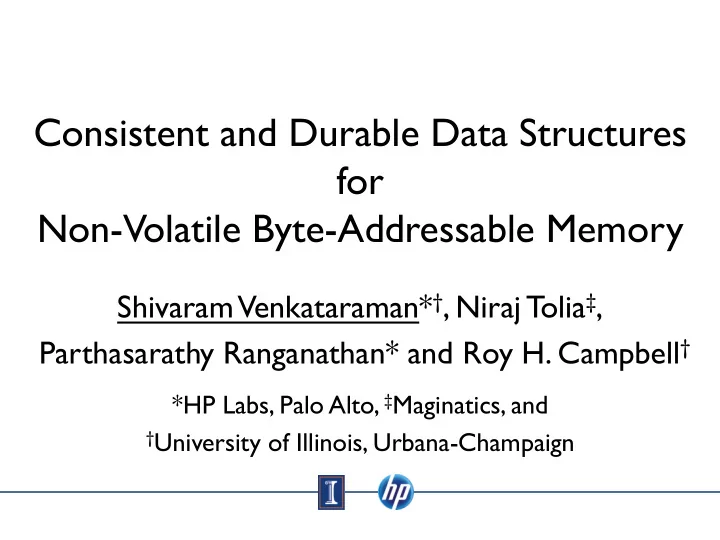

Consistent and Durable Data Structures for Non-Volatile Byte-Addressable Memory Shivaram Venkataraman* † , Niraj Tolia ‡ , Parthasarathy Ranganathan* and Roy H. Campbell † *HP Labs, Palo Alto, ‡ Maginatics, and † University of Illinois, Urbana-Champaign
Non-Volatile Byte-Addressable Memory (NVBM) Phase Change Memory Memristor Memristor 3/4/11 2
Non-Volatile Byte-Addressable Memory (NVBM) Non-Volatile 50-150 nanoseconds Scalable Lower energy Memristor 3/4/11 3
Access Times 10000000 Hard Disk Writes – 3 ms Write to SLC Flash – 200 μ s 1000000 100000 Nanoseconds 10000 1000 100 Update DRAM – 55ns Access L2 cache – 10ns 10 Processor clock cycle – 1ns 1 3/4/11 4
Access Times 10000000 Hard Disk Writes – 3 ms Write to SLC Flash – 200 μ s 1000000 100000 Nanoseconds 10000 Writes to PCM / 1000 Memristor – 100-150 ns 100 Update DRAM – 55ns Access L2 cache – 10ns 10 Processor clock cycle – 1ns 1 3/4/11 5
Data Stores - Disk Traditional DB Core1 Core2 L1 Cache L1 Cache L2 Cache L1 Cache File systems DRAM Disk 3/4/11 6
Data Stores - DRAM RAMCloud Core1 Core2 memcached L1 Cache L1 Cache L2 Cache Memory-based DB DRAM Commit Log - Disk 3/4/11 7
Data Stores - NVBM Core1 Core2 L1 Cache L1 Cache L2 Cache Single-level store Non-Volatile Memory DRAM 3/4/11 8
Challenges 10 Consistency 5 20 Durability 2 ¡ 15 1 ¡ 3/4/11 9
Outline § Motivation § Consistent durable data structures § Consistent durable B-Tree § Tembo – Distributed Data Store Implementation § Evaluation 3/4/11 10
Consistent Durable Data Structures § Versioning for consistency across failures § Restore to last consistent version on recovery § Atomic change across versions § No new processor extensions! 3/4/11 11
Versioning § Totally ordered – Increasing natural numbers § Every update creates a new version § Last consistent version § Stored in a well-known location § Used by reader threads and for recovery 3/4/11 12
Consistent Durable B-Tree Live entry Key [start, end) Deleted entry B – Size of a B-Tree node 3/4/11 13
Lookup Find key 20 at version 5 3/4/11 14
Insert / Split 3/4/11 15
Garbage Collection 3/4/11 16
Tembo – Distributed Data Store Implementation Based on open source key-value store Widely used in production In-memory dataset 3/4/11 17
Tembo – Distributed Data Store Implementation Consistent durable B-Tree Key Value Single writer, shared reader Server Consistent Hashing 3/4/11 18
Outline § Motivation § Consistent durable data structures § Consistent durable B-Tree § Tembo – Distributed Data Store Implementation § Evaluation 3/4/11 19
Ease of Integration Lines of Code Original STX B-Tree 2110 CDDS Modifications 1902 (90%) Redis (v2.0.0-rc4) 18539 Tembo Modifications 321 (1.7%) 3/4/11 20
Evaluation - Setup § API Microbenchmarks § Compare with Berkeley DB § Tembo: Versioning vs. write-ahead logging § End-to-End Comparison § NoSQL systems – Cassandra § Yahoo Cloud Serving Benchmark § 15 node test cluster § 13 servers, 2 clients § 720 GB RAM, 120 cores 3/4/11 21
Durability - Logging vs. Versioning Redis - BTree+Logging 14000 Redis - Hashtable+Logging Throughput (Ops/sec) 12000 Tembo - CDDS BTree 10000 8000 6000 4000 2000 0 256 1024 4096 Value size (bytes) 2M insert operations, two client threads 3/4/11 22
Yahoo Cloud Serving Benchmark 160000 Tembo 140000 Cassandra-inmemory 120000 Cassandra-disk 100000 Ops/sec 286% 80000 60000 40000 44% 20000 0 2 10 20 30 Client Threads 3/4/11 23
Furthermore § Algorithms for deletion § Analysis for space usage and height of B-Tree § Durability techniques for current processors 3/4/11 24
Related Work § Multi-version data structures § Used in transaction time databases § NVBM based systems § BPFS – File system (SOSP 2009) § NV-Heaps – Transaction Interface (ASPLOS 2011) § In-memory data stores § H-Store – MIT, Brown University, Yale University § RAMCloud – Stanford University 3/4/11 25
Work-in-progress § Robust reliability testing § Support for transaction-like operations § Integration of versioning and wear-leveling 3/4/11 26
Conclusion § Changes in storage media § Rethink software stack § Consistent Durable Data Structures § Single-level store § Durability through versioning § Up to 286% faster than memory-backed systems 3/4/11 27
Recommend
More recommend